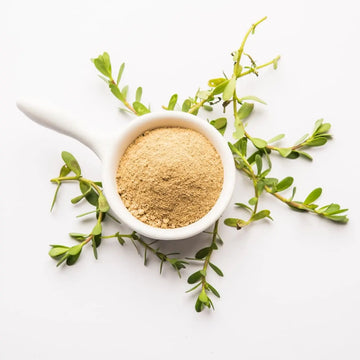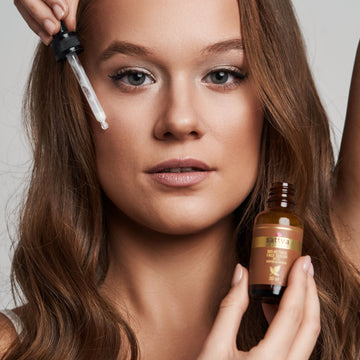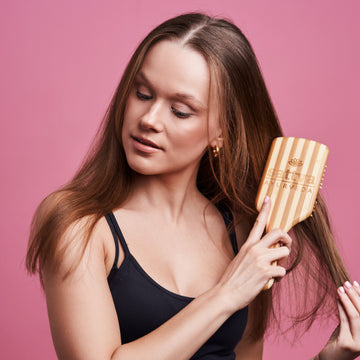The Basics of Hair Henna
Basic hair dyeing herbs: henna, indigo, cassia
Natural hair dyes are becoming increasingly popular due to their safe and effective action. The basic herbs used for hair coloring are henna, indigo and cassia. The powdered leaves of these plants, when properly prepared, release dyes, which can be used to color hair naturally.
Henna contains an orange dye molecule, indigo contains a dark blue dye molecule, and cassia contains a yellow dye molecule. These dyes combine with the hair keratin, giving the hair a permanent color. These dyes can be used separately or mixed together in different proportions to achieve the desired color on the hair.

When starting your adventure with "henna" hair, you need to be aware of what the basic coloring plants are. We invite you to review them:
1) Henna proper - Lawsonia Innermis
2) Indigo, or Indigoferia tinctoria - conditions and gives the hair a deep black, raven-like color, with bluish reflections.
3) Cassia, or Cassia obovata - most often chosen (though not only) by owners of lighter locks - it has relatively the least colouring, is transparent (gives a golden or honey glow to blonde hair), and the nourishing effect can be dazzling.
What is henna for hair ?
Henna, or Lawsonia Inermis, is a tree that grows in the hot, dry climates of North and East Africa, the Arabian Peninsula, the southern regions of the Middle East, and South Asia. India is currently the world's largest exporter of henna. Each batch of henna has a slightly different level of dye, because it is an agricultural crop that depends on weather conditions. Sattva Henna comes from ecological regions of Rajasthan from November harvests, because then the content of the dye called lawsone in the leaves is the highest. The leaves are then carefully sieved and finely ground. The ecological nature of the crop and the purity of the production process, as well as the quality of the final product have been confirmed by certification ECOCERT COSMOS NATURAL (for all colouring herbs and Sattva mixtures).

The process of dyeing hair with henna
Henna powder should be prepared for coloring according to the instructions on the packaging. Henna paste should be prepared in combination with warm water (approx. 50-60 degrees), it is also worth adding natural acidifier (such as amla, acerola or malic acid) and leave the paste for about 30 minutes to activate the coloring molecules. After this time, divide the hair into sections and apply the henna paste evenly. In order for the keratin molecules in the hair to better accept the dye, the hair should be covered with foil and wrapped in a towel to keep it warm. The coloring process should last at least three hours, the longer the time, the more saturated the resulting hair color will be.

How to Neutralize the Smell of Henna for Hair
Henna paste for coloring hair gives off a smell like hay, which can last on the hair for up to 3-4 washes. For those who don't like this smell, adding 2-3 drops of essential oil, e.g. lavender, to the mixture may help.
How does henna affect hair (apart from dyeing itself)
In addition to coloring in orange-red tones, henna nourishes and strengthens the hair, and also protects it from UV damage. It also helps to maintain hair moisture and reduces breakage. Pure henna very rarely causes allergies, but before each use of herbs it is recommended to perform an allergy test on the skin.

What is indigo for hair?
The most popular plant from which indigo blue is obtained is the indigo plant (Indigofera tinctoria L.). It is a legume plant from the legume family. The first mentions of indigo plant cultivation in Egypt and India date back to 4 thousand years BC, when it was used to dye fabrics. Indican, which occurs in plants, is obtained from indigo leaves and is subjected to enzymatic hydrolysis to indoxyl, which spontaneously oxidizes to indigo.
How to dye your hair with indigo?
Indigo dyes hair to a dark blue color. It is usually used in combination with henna (lawsonia), because this combination allows you to obtain beautiful shades of brown on the hair. Sattva Ayurveda dyeing mixtures contain combinations of henna, indigo and other herbs in various proportions. The developed recipes allowed for the development of an impressive palette of Sattva shades.
Indigo Hair Coloring - What You Need to Remember
If you see greenish shades on your hair right after coloring with indigo, don't panic. Let the dye oxidize. You'll see the final color after about 48 hours.
How does cassia work on hair?
Cassia Obovata is a plant grown in East Africa and India. In addition to its care applications, it is also interesting that this plant is also used in Ayurvedic medicine.
Cassia leaves contain the dye chrysophanol, but it is not as strong or durable as the dyes in henna or indigo. Cassia gives warm golden tones to the hair, so the color change will not be visible on darker hair.

Cassia as a hair conditioner
Cassia, however, has great care properties, gives hair spectacular shine, adds volume and softness, and also has a positive effect on the scalp: it has antibacterial and antifungal properties. Cassia as a conditioner will work well on hair dried out by thermal treatments or bleaching, and on brittle hair.
To nourish your hair, mix green cassia powder with warm water and apply it to your hair for about an hour.
How to Get Golden Tones with Cassia
To obtain a golden shade of light hair, a cassia paste can be prepared with the addition of an acidifier and left for a few hours. It is also worth extending the time of keeping cassia on the hair to 3-4 hours.
Discover the palette of shades Sattva Ayurveda coloring mixtures
Definitely less than at the hairdresser's, that's a fact. But these are as many as fifteen beautiful shades of nature from which you can choose the one you dream of.
The above herbs are the basis of SATTVA plant hair dyes. Using them in different proportions and in compositions with additional herbs, we have created a color palette that gives you an idea of what color effect you can achieve on your initial hair color.


You may also be interested in:



